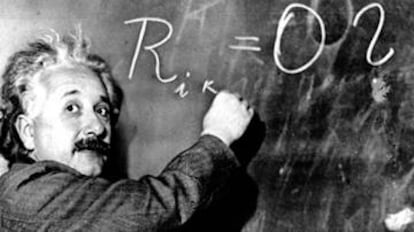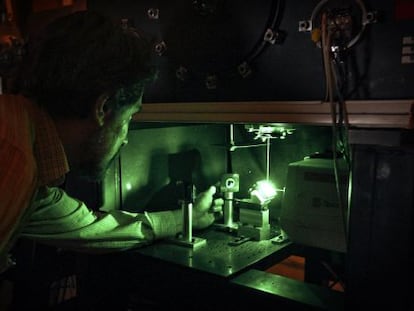Spanish planet hunter and “gravity spy” from Argentina on Top 10 Scientists list
Nature magazine hails work done by Guillem Anglada-Escudé and Gabriela González in 2016
Our small neighborhood in the universe, christened Laniakea , contains over 100,000,000,000,000,000 stars. The Sun is just one of them. And our closest neighboring star is Proxima Centauri, located 4.2 light years away. It was there, this past summer, that Spanish astronomer Guillem Anglada-Escudé and his team discovered the closest habitable world to Earth outside our solar system: Proxima b, an exoplanet that could be covered in water.

This discovery has placed Anglada-Escudé, who teaches at Queen Mary University in London, on the list of Nature magazine’s “Ten People Who Mattered This Year.”
Born in Ullastrell, near Barcelona, in 1979, the astronomer acknowledges the praise “as the visible face of a team.”
His group is now trying to determine whether Proxima b transits in front of its star at a point visible from Earth, which would enable researchers to analyze its atmosphere and confirm whether there is water. If so, it would represent a watershed in space exploration.
This is acknowledgment of the work of over 1,000 scientists
Gabriela González, physicist
“If there is transit, it’s going to be a bombshell,” he predicts.
Gabriela González
Gabriela González, a physicist from Argentina who works at Louisiana State University, also made it into Nature’s list, where she is described as a “gravity spy.”
González is the spokesperson for the Laser Interferometer Gravitational-Wave Observatory (LIGO) experiment which saw two US-based observatories, on September 14, 2015, first detect signs of the gravitational waves predicted by Albert Einstein a century earlier.

On February 11, 2016, González and her team announced their discovery to the world.
“This is acknowledgment of the work of over 1,000 scientists,” she says.
Gravitational waves are vibrations in space-time. What González and her colleagues saw on September 14 was a deformation of space and time caused by a gravitational wave formed by two black holes clashing 1.3 billion years ago.
“This is just the beginning. We are going to continue discovering gravitational waves, star collisions, we will witness the birth of a black hole...We now have a new way of looking at the sky,” celebrates González, who was born in Córdoba (Argentina) in 1965.
English version by Susana Urra.
Tu suscripción se está usando en otro dispositivo
¿Quieres añadir otro usuario a tu suscripción?
Si continúas leyendo en este dispositivo, no se podrá leer en el otro.
FlechaTu suscripción se está usando en otro dispositivo y solo puedes acceder a EL PAÍS desde un dispositivo a la vez.
Si quieres compartir tu cuenta, cambia tu suscripción a la modalidad Premium, así podrás añadir otro usuario. Cada uno accederá con su propia cuenta de email, lo que os permitirá personalizar vuestra experiencia en EL PAÍS.
¿Tienes una suscripción de empresa? Accede aquí para contratar más cuentas.
En el caso de no saber quién está usando tu cuenta, te recomendamos cambiar tu contraseña aquí.
Si decides continuar compartiendo tu cuenta, este mensaje se mostrará en tu dispositivo y en el de la otra persona que está usando tu cuenta de forma indefinida, afectando a tu experiencia de lectura. Puedes consultar aquí los términos y condiciones de la suscripción digital.
More information
Últimas noticias
A floating school teaches children how to save Lake Atitlán
Pablo Escobar’s hippos: A serious environmental problem, 40 years on
The brief rise and retreat of Generation Z in Mexico
From Andorra to Gibraltar, a black market for Ozempic exploits its success: ‘They’re the most sought-after products in the world’
Most viewed
- Why we lost the habit of sleeping in two segments and how that changed our sense of time
- Charles Dubouloz, mountaineering star, retires at 36 with a farewell tour inspired by Walter Bonatti
- Venezuela faces its most tense Christmas yet
- Trump’s obsession with putting his name on everything is unprecedented in the United States
- CBS in crisis after pulling a report on Trump’s deportations to El Salvador (which later leaked online)











































